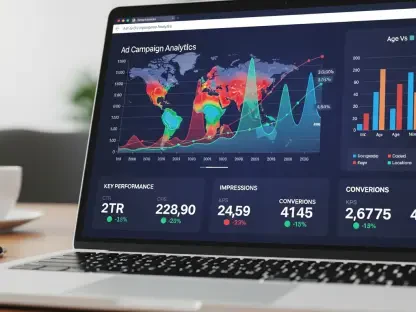Setting the Stage: The Data-Driven Revolution in Business
Imagine a world where businesses can predict customer needs before they even arise, detect fraud in real time, and make strategic decisions with pinpoint accuracy—all powered by technology that mimics human reasoning. This is the promise of cognitive analytics, a rapidly evolving field that leverages artificial intelligence (AI), machine learning (ML), and natural language processing (NLP) to transform raw data into actionable insights. As of 2025, the global cognitive analytics market stands at a staggering valuation of USD 5.12 billion, with projections estimating growth to USD 44.92 billion by 2032, reflecting a compound annual growth rate (CAGR) of 31.2%. This explosive trajectory underscores the urgency for companies to adapt to a data-centric landscape or risk obsolescence in an increasingly competitive environment.
The significance of this market cannot be overstated. With industries like healthcare, finance, and retail grappling with unprecedented volumes of structured and unstructured data, the ability to derive meaningful insights has become a cornerstone of success. This analysis aims to dissect the current state of the cognitive analytics market, explore key trends shaping its evolution, and provide a forward-looking perspective on its impact through 2032. By delving into market dynamics, regional disparities, and technological advancements, the goal is to equip stakeholders with a comprehensive understanding of opportunities and challenges in this transformative space.
Diving Deep: Market Trends, Data Insights, and Future Projections
Market Valuation and Growth Drivers
The cognitive analytics market is on a remarkable upward trajectory, fueled by the pressing need for intelligent, data-driven solutions across diverse sectors. Starting from USD 5.12 billion in 2025, forecasts indicate a surge to USD 44.92 billion by 2032, driven by a robust CAGR of 31.2%. This growth is primarily propelled by the escalating demand for real-time analytics, as businesses seek to respond swiftly to market shifts and consumer behaviors. Industries such as retail and finance are leading the charge, adopting cognitive tools to process vast datasets and maintain a competitive edge in dynamic environments.
Beyond sheer numbers, the adoption of AI and ML technologies serves as a critical engine for this expansion. These innovations enable systems to learn from data patterns, predict outcomes, and automate complex decision-making processes without explicit human intervention. The proliferation of digital transformation initiatives further accelerates market growth, as companies prioritize integrating intelligent systems into their core operations. However, barriers such as high implementation costs and data privacy concerns remain, particularly for small and medium-sized enterprises (SMEs) navigating limited budgets and stringent regulations.
Dominance of Cloud-Based Solutions and Deployment Trends
A pivotal trend shaping the market is the overwhelming dominance of cloud-based cognitive analytics platforms. These solutions lead due to their scalability, cost-effectiveness, and ease of deployment, making them accessible to organizations of varying sizes. Cloud systems facilitate real-time data processing and elastic storage, which are indispensable in today’s remote work and digitization era. This segment’s prominence is evident as enterprises leverage cloud tools to handle increasing data loads without the burden of extensive on-premises infrastructure.
Hybrid deployment models, combining the security of on-premises systems with cloud agility, are emerging as the fastest-growing segment. They cater to industries like healthcare and finance, where data sovereignty and compliance with regulations are paramount. This balance of flexibility and control positions hybrid solutions as a preferred choice for businesses with stringent security needs. Meanwhile, on-premises options, though less dominant, continue to appeal to firms prioritizing complete control over sensitive information, highlighting the diverse needs within the market.
Key Applications Fueling Demand Across Industries
Drilling into specific applications, customer insights stand out as a leading use case for cognitive analytics. Businesses in retail and telecommunications harness this technology to analyze consumer behavior, preferences, and social media interactions, enabling highly personalized experiences that boost loyalty and retention. The precision of cognitive tools in segmenting and predicting customer trends offers a stark contrast to traditional broad-based approaches, providing a granular understanding of market demands.
Simultaneously, fraud detection is identified as the fastest-growing application, spurred by the rise in digital transactions and escalating cybersecurity threats. Financial institutions and e-commerce platforms utilize cognitive systems to detect anomalies in transaction data instantly, mitigating risks before they escalate. Other applications, such as predictive maintenance in manufacturing and risk management in banking, also gain traction, showcasing the technology’s versatility in addressing operational challenges across varied sectors. This adaptability underscores its value as a multifaceted tool for modern enterprises.
Regional Dynamics and Global Adoption Patterns
Geographically, North America commands the largest share of the cognitive analytics market, driven by advanced IT infrastructure and substantial R&D investments, particularly in the United States. The region benefits from a concentration of tech giants and a mature enterprise analytics ecosystem, positioning it as a global leader. Canada, meanwhile, shows rapid growth within the region, fueled by healthcare digitization and supportive government policies promoting predictive analytics.
Asia Pacific emerges as a high-growth area, with countries like Japan and South Korea leading due to significant investments in digital transformation and intelligent ecosystems. Japan’s precision-driven industries and South Korea’s focus on smart city infrastructure and 5G-enabled analytics highlight the region’s innovative edge. Europe, with key players like Germany, France, and the UK, balances technological advancement with regulatory caution, adhering to strict data privacy frameworks like GDPR while pushing forward in manufacturing and public sector applications. These regional disparities illustrate a complex global landscape of adoption and opportunity.
Technological Convergence and Industry-Specific Innovations
A defining trend in the market is the convergence of cognitive analytics with complementary technologies such as AI, ML, and business intelligence (BI) tools. This integration enhances the capability to process diverse data types, from financial records to social media posts, delivering actionable insights with unprecedented speed. The focus on natural language querying further democratizes access, allowing non-technical users to interact with data systems effortlessly, thereby broadening the technology’s reach within organizations.
Another notable shift is toward industry-specific solutions tailored to unique regulatory and operational challenges. For instance, healthcare organizations employ cognitive analytics for predictive diagnostics, while financial institutions prioritize fraud prevention and risk assessment. This customization ensures relevance and accelerates return on investment, making the technology indispensable for sector-specific strategies. As costs of cloud-based platforms decrease, accessibility continues to improve, promising wider adoption across industries by 2032.
Challenges and Barriers to Market Penetration
Despite its potential, the cognitive analytics market faces significant hurdles that could temper growth. Data privacy concerns loom large, as handling sensitive information risks breaches and regulatory penalties under frameworks like GDPR. These issues are particularly acute in regions with strict compliance requirements, necessitating robust security measures and transparent data practices to maintain consumer trust and legal adherence.
High implementation costs also pose a barrier, encompassing infrastructure, software, and skilled personnel expenses. For SMEs in cost-sensitive markets, these upfront investments can be prohibitive, limiting market penetration. Additionally, integrating cognitive analytics with legacy systems often presents technical challenges, requiring customized solutions that further inflate costs. Addressing these obstacles will be crucial for ensuring equitable access to the technology’s benefits over the coming years.
Competitive Landscape and Strategic Innovations
The market exhibits a vibrant competitive environment, with established players and agile startups driving innovation. Major corporations like IBM, Microsoft, and Oracle focus on comprehensive platforms, integrating cognitive analytics into broader enterprise systems to enhance scalability and efficiency. Their emphasis on user accessibility targets large organizations seeking end-to-end solutions for complex data needs.
Startups, on the other hand, carve out niches by offering specialized, user-friendly tools. These emerging players prioritize agility, delivering no-code platforms and contextual decision intelligence tailored to specific industries like retail and finance. This blend of legacy strength and startup innovation fosters a dynamic ecosystem, pushing the boundaries of what cognitive analytics can achieve and ensuring continuous technological progress through 2032.
Reflecting on Insights: Strategic Implications and Next Steps
Looking back, the analysis of the cognitive analytics market revealed a landscape of immense potential, marked by rapid growth from USD 5.12 billion in 2025 to a projected USD 44.92 billion by 2032. The technology proved to be a transformative force across industries, with applications like customer insights and fraud detection addressing critical business needs. Regional leaders such as North America and high-growth areas like Asia Pacific demonstrated varied adoption patterns, while challenges including privacy concerns and high costs highlighted areas for improvement.
Moving forward, businesses need to prioritize scalable cloud-based solutions to manage expenses effectively while investing in employee training to bridge skill gaps. Establishing robust data governance frameworks emerges as essential to navigate privacy regulations and build consumer trust. Starting with pilot projects in targeted departments, such as customer service, offers a practical entry point before scaling enterprise-wide. By aligning with industry-specific trends and integrating cognitive tools with existing BI systems, companies can position themselves to capitalize on this data-driven era, ensuring long-term resilience and competitiveness.









